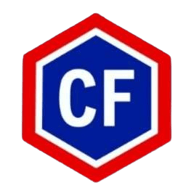Fasteners Solutions
Leading importers and exporters of high-quality fasteners worldwide.




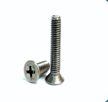



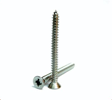











Cheese Head Machine Screw
Cylindrical head with flat top and straight sides
Offers a larger contact surface compared to pan heads
Commonly used in electrical components, precision machinery, and metal fittings
Chicago Screw
Countersunk Head Screw
Flat head with a conical shape, sits flush with the surface after installation
Typically made of stainless steel or zinc-coated steel
Commonly used in metal fittings, electrical equipment, and furniture
Domed (Rounded) Head Screw
These are typically made of metal and used in leathercraft, belts, bags, and folders where a smooth, finished look is desired on one side.
Button Head Cap Screw
Hex Washer Head Screw
Torx Pan Head Screw
Truss Head Screw
Pan Head Screw
Two-part construction: barrel + screw
Durable metal body for long-lasting strength
Reusable without damaging material
Flat Head Screw
Multiple drive options for flexible tool compatibility
High-strength threading for reliable fastening
Suitable for pre-tapped holes or use with nuts
Smooth, rounded button head for a finished look
Ideal for applications with limited clearance
High tensile strength for mechanical reliability
Corrosion-resistant finishes available
Self-drilling tip eliminates the need for pilot holes
Hex washer head provides superior drive control
Built-in EPDM washer ensures water-tight sealing
Available in multiple lengths and diameters
Torx drive allows higher torque and prevents stripping
Rounded pan head for clean, finished appearance
Consistent, secure fastening in high-vibration environments
Rust-resistant finish options for durability
Extra-wide, low-profile head for maximum surface contact
Smooth, clean appearance—ideal for exposed surfaces
Excellent for fastening soft or thin materials
Corrosion-resistant finishes available
Clean, rounded head with flat bottom for a flush fit
Multiple drive styles for versatile applications
High-strength threading for durable fastening
Compatible with metal, plastic, and wood surfaces
Socket Head






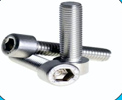

Hex Socket Head Cap
designed to be tightened or loosened using a hex (Allen) wrench.
It is commonly used in machinery, automotive, and industrial applications where high strength and a flush finish are required.
Hex Socket Button Head
This design offers a sleek appearance and reduced risk of snagging or damage compared to traditional cap screws.
Typically made from alloy steel, stainless steel, or black oxide-coated materials .
Allen Socket Head
Cylindrical with a recessed hexagonal drive
Tightened or loosened using an Allen wrench
Common in machine parts, tools, and assemblies where a strong, clean, and flush fit is needed
Socket Head(Various Types)
This assortment includes different types of socket-based fasteners, often used in precision assemblies like machinery, automotive, and aerospace.
Rounded low-profile head with a hex socket.
BOLTS
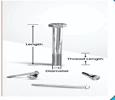



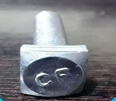

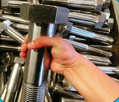

Countersunk Head Blind Rivet
Tubular, which expands on the blind side of the material during installation
Ideal for applications where a smooth surface finish is needed and only one side of the assembly is accessible.
Hex Head Bolt
Six-sided (hexagonal), designed to be driven with a wrench or socket.
Partially or fully threaded cylindrical shaft.
Often made from stainless steel, carbon steel, or alloy steel.
Square Head Bolt
Square-shaped, which provides a larger surface for tightening using a wrench
Typically unthreaded shank with threads at the end.
Often made from steel with a galvanized finish for rust resistance
Heavy Hex Bolt
Hexagonal (six-sided), but larger and thicker than standard hex bolts for added strength.
Partially threaded with a thick, high-strength body.
Significantly larger than typical bolts, as seen by the hand for scale.
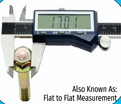







Digital Caliper
A precision measuring instrument displaying a reading of 17.01 mm, which represents the flat-to-flat distance across the hex head of the bolt.
This value is crucial in determining the correct wrench or socket size for installation or removal.
Compatibility with design tolerances
T-Head Bolts
The head is shaped like a "T", allowing the bolt to be inserted into a T-slot track.
Designed to slide into T-slots and lock in place when tightened.
Often made from steel or stainless steel, with a rough or coated finish depending on the application.
Hex Head Bolts (Yellow Zinc Plated)
Standard six-sided (hex) head, designed for use with a wrench or socket.
Typically partially or fully threaded, depending on the application.
Used in construction, automotive, machinery, and electrical assemblies
Suitable for indoor or mildly corrosive environments due to the zinc coating
Cotter Pin Type Foundation Bolts
Hex head for standard tightening.
A drilled hole near the threaded end or middle of the shank for inserting a cotter pin or locking wire.
The hole allows a pin or wire to be inserted after tightening, preventing loosening due to vibration or dynamic loading.
Equipment bases requiring vibration resistance
NUTS


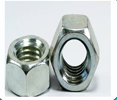

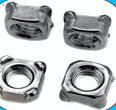

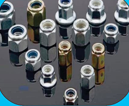

Flange Nut
A flange nut features a wide flange at one end, which acts like a washer to distribute the load and prevent damage to the surface being fastened.
The serrated underside of the flange helps to grip the material surface, providing resistance to loosening due to vibration.
Hex Nut
A hex nut is a six-sided fastener with internal threads that is used in conjunction with a bolt or screw to fasten materials together.
They are typically made from steel, stainless steel, brass, or nylon and are available in various grades .
Cage Nut
A cage nut (also known as a clip nut or captive nut) consists of a square nut encased in a spring steel cage that wraps around the nut.
The cage has two wings or tabs that compress to allow insertion into a square hole, after which they snap back to hold the nut in place.
Nyloc Nut
A nylon insert lock nut, commonly known as a Nyloc nut, is a type of locking nut that features a nylon collar insert.
The insert grips the threads of the bolt when tightened, providing resistance to loosening caused by vibration and torque.
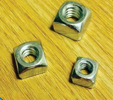

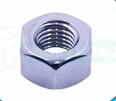





Square Nut
A square nut is a four-sided nut with internal threads, providing a greater surface area in contact with the part being fastened compared to hex nuts.
They are easier to grip with tools and are ideal for use in tight or hard-to-reach spaces where a wrench or pliers can easily hold the flat sides.
Coupler Nut
A hex coupling nut is a long, hexagonal-shaped nut used to connect two male threaded rods or studs. Its extended body provides more thread engagement and allows for a secure, aligned joint between parts.
Coupling nuts are often used in threaded rod assemblies, suspension systems, electrical installations.
Lock Nut
A jam nut, also known as a thin hex nut, is a low-profile nut typically used as a locking mechanism against another standard nut.
It is tightened against the main nut to prevent loosening caused by vibration or torque.
Jam nuts are often used in double-nut locking arrangements, electrical components, and tight-clearance applications.
Nylon Insert Lock Nut
A nylon insert lock nut, or Nyloc nut, features a nylon ring at the top of the nut. This ring deforms as the nut is tightened, gripping the bolt threads and creating a frictional force that resists loosening due to vibration or movement.
These nuts are commonly used in automotive, aerospace, and machinery applications. The nylon insert also helps seal out moisture.
WASHER
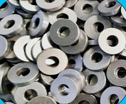

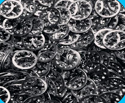



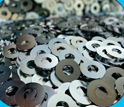

Flat Washer
A flat washer is a thin, round disk with a hole in the center, typically made from metal or plastic. It is used to distribute the load of a threaded fastener
Flat washers also help to prevent loosening in vibrating environments and can provide spacing or insulation. Commonly used in construction, automotive, machinery,
Star Washer
A star washer, specifically an internal tooth lock washer, features multiple teeth pointing inward from the inner edge. These teeth bite into the surface of the connected material and the mating fastener (like a screw or bolt)
Star washers are often used in electrical applications, automotive assemblies, and metal fastenings where a more secure grip is required.
Spring Washer
A spring washer is a type of lock washer made of metal and split at one point with a slight curve or twist.
It is designed to exert a spring force between the head of the bolt and the substrate, maintaining tension and preventing loosening due to vibration or torque.
Common Use: Machinery, automotive, and electrical applications
Plain Washers
A plain washer is a flat, circular metal disc with a central hole. It is typically placed between a fastener (like a bolt or screw)
And the surface it's securing to distribute the load of the fastener, reduce friction, prevent leakage, and protect the surface from damage.
Common Use: General-purpose fastening in construction, automotive, machinery, and electronics
MORE FASTENERS
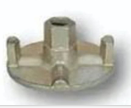



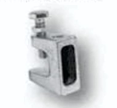

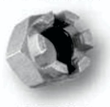

Anchor Nut
An anchor nut is a type of fastener designed to be embedded in a structure or surface to provide a secure threaded hole.
It's commonly used in concrete, aerospace, and industrial applications to allow bolts to be easily installed or removed.
Barrel Nut
Cross-threaded hole allows a bolt to pass through and thread into the nut at a 90° angle.
Used in woodworking, metal fabrication, furniture assembly, and structural joints.
Provides strong tensile strength and resistance to pull-out forces.
Beam Clamp
C-shaped body designed to grip the edge or flange of a steel beam.
Includes a tightening screw or bolt that clamps the device securely onto the beam.
Made from steel or ductile iron and often zinc-plated or galvanized for corrosion resistance.
Castle Nut
A castle nut is a type of locknut with slots (notches) cut into one end.
It is designed to be used with a cotter pin and a drilled bolt to prevent loosening due to vibration or torque.
The nut is tightened to a specified torque, then aligned with a hole in the bolt, and a cotter pin is inserted through the slots to lock it in place.
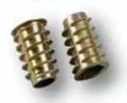

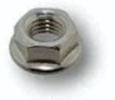

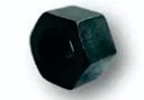



D Nut
A D Nut is a type of threaded insert designed for use in wood, particle board, or MDF.
It allows machine screws to be securely fastened in wooden materials, providing a strong and reusable metal thread in softer substrates.
Flange Nut
A flange nut is a hex nut with a wide flange at one end, which acts like a built-in washer.
This flange distributes the clamping load over a larger surface area, reducing the risk of damage to the connected material and helping to prevent loosening.
Heavy Hex Nut
It has a larger width across flats and a greater thickness, offering increased strength and load-bearing capability.
These nuts are typically used in structural and high-stress applications where standard nuts would be insufficient.
Insert Nut
A rivet nut is a tubular rivet with internal threads. It is installed into thin or soft materials (like sheet metal or plastic)
Once inserted, it is deformed (typically using a special rivet nut tool) to grip the material.
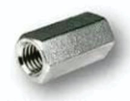

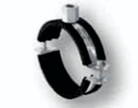



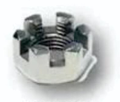

Long Nut
A long nut is a hexagonal fastener with internal threads used to join two male threads, typically threaded rods or bolts.
These nuts are longer than standard hex nuts to provide greater strength and thread engagement.
Pipe Clamp
A pipe clamp is a fastening device used to secure pipes to walls, ceilings, or floors.
The version shown in the image includes a rubber lining, which helps dampen vibrations, reduce noise, and protect the pipe surface from damage.
Self-Lock Nut
A self-locking nut is a type of hex nut that includes a nylon insert collar.
The nylon insert grips the bolt threads, increasing friction and preventing the nut from loosening under vibration or torque.
Slotted Nut
A slotted nut is a hexagonal nut with vertical slots cut into one end, used with a cotter pin and drilled bolt to prevent loosening.
The name "castle nut" comes from its resemblance to the turrets of a castle.
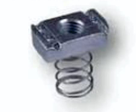

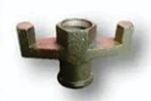



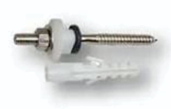

Spring Nut
It features a threaded nut combined with a spring, which holds the nut in place during installation inside the channel.
The spring helps position and retain the nut, allowing for easy and secure component mounting.
Wing Nut
A wing nut is a type of fastener with two large metal "wings" on either side, allowing it to be easily tightened and loosened by hand without tools.
The design enables quick assembly or disassembly, especially in applications where adjustments are frequently needed.
U-Bolt
A U-bolt is a U-shaped fastener with two threaded arms that extend from a curved base.
It is designed to secure round or cylindrical objects, such as pipes or tubes, to a surface or structure.
Usually made of stainless steel, galvanized steel, or carbon steel
Rack Bolt
A rack bolt is a two-part fixing system consisting of a bolt and plastic plug (rawl plug), commonly used to secure wall-hung items like toilet pans, basins, or cisterns.
It is designed for hidden or flush mounting, offering both strength and a clean appearance.
